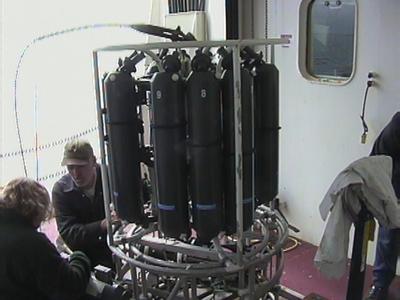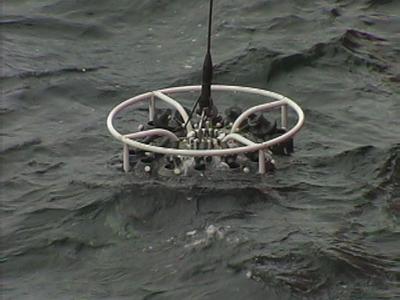12 July, 2003
Science On the Sea
After a tour of the ship, a fire drill, an abandon ship drill, a
science meeting and final frantic instrument calibrations and set up we
arrive at our first survey site. Like bees swarming a hive or ants at a
picnic or - well you get the idea. Everyone was excited and all crowded
around the CTD lab and adjoining equipment deployment bay to watch the first
instruments lowered into the water.
At 19:00 (7:00 PM) the ships engines stopped at latitude North 56.312
degrees and West -172.824 degrees. Below us lay roughly 1300 meters of
Bering Sea saltwater and our first site. The site is one of five that we
will stop at and collect samples and data that are clustered in a relatively
small area. At each of these five stations the CTD equipment array,
consisting of instruments to measure water depth, temperature, salinity and
chlorophyll, will be lowered. A series of twelve water collection bottles
form a rosette on the CTD frame. Each opening to the collection bottle has a
trigger, which will open the bottle at prescribed depths programmed into the
system, thus collecting water samples at various depths each instrument
deployment.
The crew of the Laurier connects the CTD to a winch and the instruments
are slowly lowered into the water. As the whole array descends real time
data is collected on the waters temperature, salinity, depth and a
fluorometer measures the chlorophyll. Jane Eert monitors the descent from
the CTD lab and keeps track, through an electronic link, that all prescribed
triggers have fired and appropriate water samples taken. Once the CTD has
reached its depth the instruments are slowly raised back on deck.
Once the Laurier crew has secured the CTD back on deck water samples
are drawn from the collection bottles. On this parcticular trip two separate
teams are collecting samples for thier projects. Dr. Cooper and his
associates are collecting samples as well as Dr. Lee and his assistant.
Dr. Cooper's group (the group I am assigned to) extracts the water from
the bottles then runs it through a pump to filter out the phytoplankton. The
phytoplankton is then frozen (to "crack" the cell membrane) in order to make
the chlorophyll extraction easier. Once the chlorophyll is extracted and
stabilized, using acetone, the sample is run through the fluorometer more
accurate than the one deployed on the CTD) to measure the chlorophyll
amounts.
Dr. Lee's team is also filtering out the phytoplankton but for a
different reason. His interests are in the phytoplankton's dimethylsulfide
(DMSO), dimethlsulfide (DMS) and dimethyl-sulfoniopropionate (DMSP), the
pigments within the phytoplankton and the enzyme activity involved in the
conversion of DMSP to DMS.
Dr. Cooper's work focuses on the first stages of the Arctic food chain
and the fluctuations of the nutrients and phytoplankton in the region
whereas Dr. Lee's work focuses on some of the trace biogenic gases that have
been implicated in significantly affecting global climate change processes.
Both projects have significant implications as to the health status of these
fragile frigid waters and the Arctic ecosystem.

1. Preparing the CTD for deployment

CTD in water

1. Preparing the CTD for deployment
Contact the TEA in the field at
.
If you cannot connect through your browser, copy the
TEA's e-mail address in the "To:" line of
your favorite e-mail package.
|
